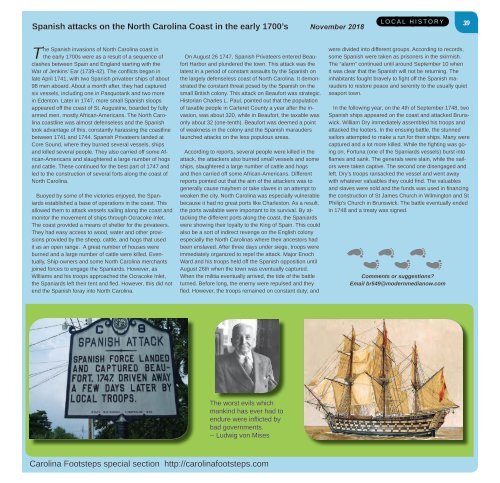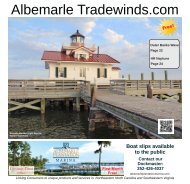Tradewinds November 2018 Web Opt
Albemarle Tradewinds November 2018 is now online. Look for the printed edition later in the week at your favorite location
Albemarle Tradewinds November 2018 is now online. Look for the printed edition later in the week at your favorite location
You also want an ePaper? Increase the reach of your titles
YUMPU automatically turns print PDFs into web optimized ePapers that Google loves.
Spanish attacks on the North Carolina Coast in the early 1700’s<br />
<strong>November</strong> <strong>2018</strong><br />
LOCAL HISTORY 39<br />
The Spanish invasions of North Carolina coast in<br />
the early 1700s were as a result of a sequence of<br />
clashes between Spain and England starting with the<br />
War of Jenkins’ Ear (1739-42). The conflicts began in<br />
late April 1741, with two Spanish privateer ships of about<br />
98 men aboard. About a month after, they had captured<br />
six vessels, including one in Pasquotank and two more<br />
in Edenton. Later in 1747, more small Spanish sloops<br />
appeared off the coast of St. Augustine, boarded by fully<br />
armed men, mostly African-Americans. The North Carolina<br />
coastline was almost defenseless and the Spanish<br />
took advantage of this, constantly harassing the coastline<br />
between 1741 and 1744. Spanish Privateers landed at<br />
Core Sound, where they burned several vessels, ships<br />
and killed several people. They also carried off some African-Americans<br />
and slaughtered a large number of hogs<br />
and cattle. These continued for the best part of 1747 and<br />
led to the construction of several forts along the coast of<br />
North Carolina.<br />
Buoyed by some of the victories enjoyed, the Spaniards<br />
established a base of operations in the coast. This<br />
allowed them to attack vessels sailing along the coast and<br />
monitor the movement of ships through Ocracoke Inlet.<br />
The coast provided a means of shelter for the privateers.<br />
They had easy access to wood, water and other provisions<br />
provided by the sheep, cattle, and hogs that used<br />
it as an open range. A great number of houses were<br />
burned and a large number of cattle were killed. Eventually,<br />
Ship-owners and some North Carolina merchants<br />
joined forces to engage the Spaniards. However, as<br />
Williams and his troops approached the Ocracoke Inlet,<br />
the Spaniards left their tent and fled. However, this did not<br />
end the Spanish foray into North Carolina.<br />
On August 26 1747, Spanish Privateers entered Beaufort<br />
Harbor and plundered the town. This attack was the<br />
latest in a period of constant assaults by the Spanish on<br />
the largely defenseless coast of North Carolina. It demonstrated<br />
the constant threat posed by the Spanish on the<br />
small British colony. This attack on Beaufort was strategic.<br />
Historian Charles L. Paul, pointed out that the population<br />
of taxable people in Carteret County a year after the invasion,<br />
was about 320, while in Beaufort, the taxable was<br />
only about 32 (one-tenth). Beaufort was deemed a point<br />
of weakness in the colony and the Spanish marauders<br />
launched attacks on the less populous areas.<br />
According to reports, several people were killed in the<br />
attack, the attackers also burned small vessels and some<br />
ships, slaughtered a large number of cattle and hogs<br />
and then carried off some African-Americans. Different<br />
reports pointed out that the aim of the attackers was to<br />
generally cause mayhem or take slaves in an attempt to<br />
weaken the city. North Carolina was especially vulnerable<br />
because it had no great ports like Charleston. As a result,<br />
the ports available were important to its survival. By attacking<br />
the different ports along the coast, the Spaniards<br />
were showing their loyalty to the King of Spain. This could<br />
also be a sort of indirect revenge on the English colony<br />
especially the North Carolinas where their ancestors had<br />
been enslaved. After three days under siege, troops were<br />
immediately organized to repel the attack. Major Enoch<br />
Ward and his troops held off the Spanish opposition until<br />
August 26th when the town was eventually captured.<br />
When the militia eventually arrived, the tide of the battle<br />
turned. Before long, the enemy were repulsed and they<br />
fled. However, the troops remained on constant duty; and<br />
were divided into different groups. According to records,<br />
some Spanish were taken as prisoners in the skirmish.<br />
The “alarm” continued until around September 10 when<br />
it was clear that the Spanish will not be returning. The<br />
inhabitants fought bravely to fight off the Spanish marauders<br />
to restore peace and serenity to the usually quiet<br />
seaport town.<br />
In the following year, on the 4th of September 1748, two<br />
Spanish ships appeared on the coast and attacked Brunswick.<br />
William Dry immediately assembled his troops and<br />
attacked the looters. In the ensuing battle, the stunned<br />
sailors attempted to make a run for their ships. Many were<br />
captured and a lot more killed. While the fighting was going<br />
on, Fortuna (one of the Spaniards vessels) burst into<br />
flames and sank. The generals were slain, while the sailors<br />
were taken captive. The second one disengaged and<br />
left. Dry’s troops ransacked the vessel and went away<br />
with whatever valuables they could find. The valuables<br />
and slaves were sold and the funds was used in financing<br />
the construction of St James Church in Wilmington and St<br />
Philip’s Church in Brunswick. The battle eventually ended<br />
in 1748 and a treaty was signed.<br />
Comments or suggestions?<br />
Email br549@modernmedianow.com<br />
The worst evils which<br />
mankind has ever had to<br />
endure were inflicted by<br />
bad governments.<br />
-- Ludwig von Mises<br />
Carolina Footsteps special section http://carolinafootsteps.com

















